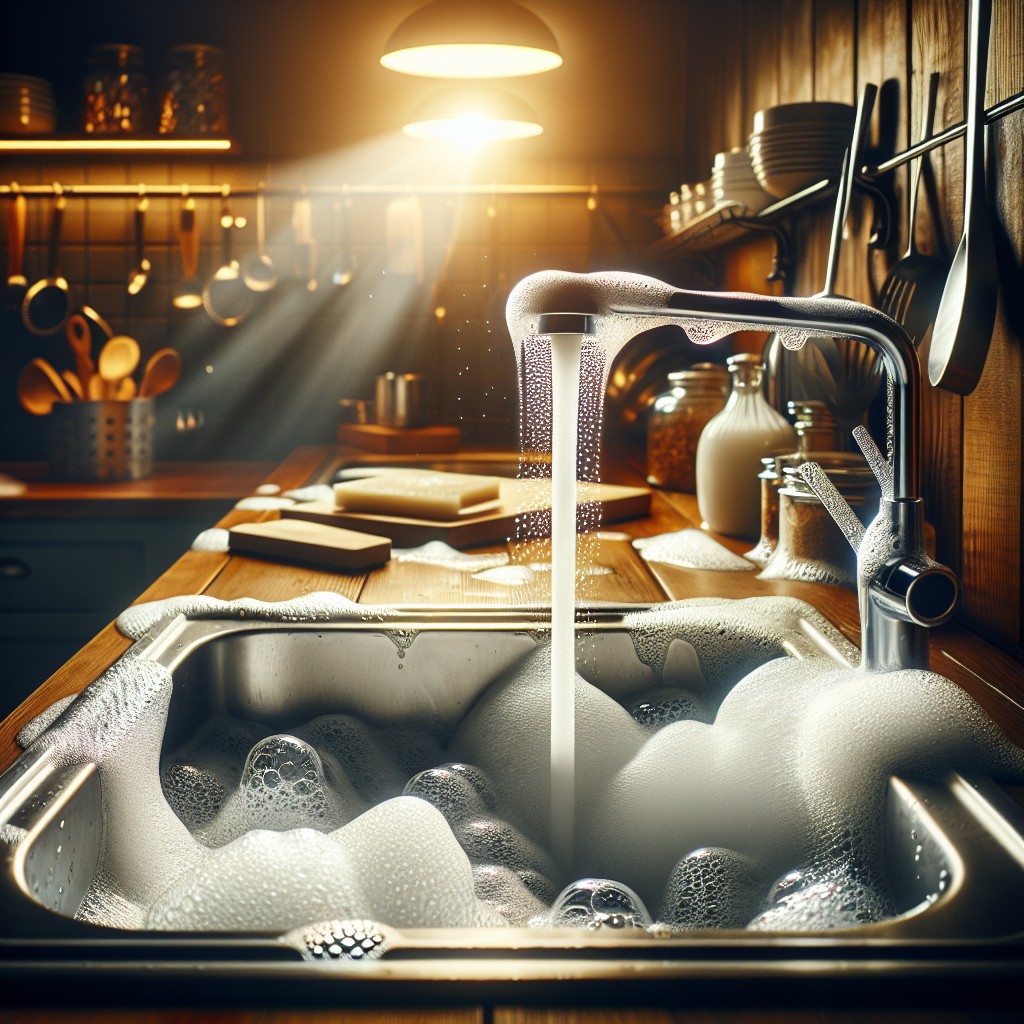Last updated on
In this article, you’ll learn foolproof methods to effectively remove unwanted odors from your kitchen sink and keep it smelling fresh every day.
Key takeaways:
- Regularly clean sink with soap and hot water
- Pour baking soda down the drain
- Use white vinegar for deodorizing
- Inspect and clear the P-trap
- Avoid fats, oils, and grease down the sink
What's Inside
Regularly Clean Your Sink With Soap and Hot Water

Maintaining a pristine kitchen sink is pivotal in combatting odor emergence. A daily regimen using dish soap teamed with boiling water can effectively dissolve food particles and deter the buildup of residue that might lead to unpleasant smells.
Here are some quick, actionable steps:
- After dishwashing, douse the basin with hot, soapy water, scrubbing around the drain and sink sides using a sponge or brush.
- Rinse out the sink thoroughly to ensure no soap scum remains, as this could contribute to future odors.
- For best results, integrate this practice into your evening cleanup routine to keep your sink fresh overnight.
By making this simple process a habit, you foster a first line of defense against the development of stubborn, smelly sink issues.
Pour Baking Soda Down the Drain
Harness the deodorizing power of baking soda. Its alkaline nature enables it to break down organic substances and neutralize foul odors. For a straightforward remedy, sprinkle half a cup of baking soda directly into the drain. Allow it to sit, working its magic for 10-30 minutes; the longer, the better, especially for stronger smells.
Now, boil a kettle of hot water. Carefully pour the steaming water down the drain to flush the baking soda and any dislodged grime. This process not only tackles unpleasant smells but also can dislodge minor blockages, making it a simple yet effective maintenance routine.
Baking soda acts as a gentle abrasive, scrubbing away biofilm—a sticky colony of bacteria and food particles—that could be the source of odors. Remember, this isn’t a one-time fix, but rather a practice best done weekly to maintain a fresh-smelling kitchen sink.
Use White Vinegar
White vinegar isn’t just a cooking staple; it’s also a fantastic deodorizer due to its acidic nature, which helps neutralize odors. To leverage its power, heat a cup of white vinegar until it’s warm, not boiling, and pour it down the drain. Allow it to work its magic for about 30 minutes; the warmth and acidity will help break down and remove odor-causing bacteria and build-up.
For an extra fresh scent, after the vinegar has sat, sprinkle baking soda down the drain followed by another cup of warm vinegar. The combination fizzes upon contact, providing a gentle yet effective scrubbing action that can reach deeper into the pipe. After the fizzing subsides, flush the sink with hot water to wash away the residue. This simple, eco-friendly method doesn’t just mask odors – it eradicates them, leaving your sink smelling clean without the use of harsh chemicals.
Inspect and Clear the P-Trap
The P-trap, which is the curved pipe under your sink, serves as a moisture seal, preventing sewer gases from entering the home. However, it can also act as a catchment area for debris, leading to unpleasant odors. To tackle smells coming from this area:
1. Place a bucket underneath the P-trap to catch any water or debris that may fall out when you disassemble the pipe.
2. Unscrew the connectors that hold the P-trap in place. These can usually be loosened by hand or with pliers if they’re particularly tight.
3. Once removed, empty the contents into the bucket, and rinse the trap thoroughly with water.
4. For a deeper clean, use an old toothbrush to scrub the interior surfaces of the trap to remove the build-up of gunk and biofilm.
5. After cleaning, reattach the P-trap, ensuring that all connections are tight to prevent leaks.
6. Run water through the pipe to test for leaks and confirm that the odor issue is resolved.
Remember that regular maintenance of the P-trap can prevent smells before they start, so consider adding this to your routine sink care every few months.
Avoid FOG (Fats, Oils, and Grease) Down the Sink
The accumulation of fats, oils, and grease, often referred to by the acronym FOG, can cause severe blockages in your kitchen pipes. It’s a common misconception that these substances can be flushed down with hot water, as they eventually cool and solidify, leading to odor-causing clogs.
To prevent this:
- Scrape leftover food, grease, and oil from pans and plates into the trash before washing them.
- Use a paper towel to wipe down greasy pans prior to washing.
- Consider installing a grease trap or catcher in your sink to collect oil and grease – an effective method for preventing drain blockage.
- For small amounts of oil used in frying, let it cool and then pour into a sealable container before disposing of it with the trash.
- Educate your household about the importance of keeping FOG out of the sink to maintain a fresh-smelling kitchen.
By consciously diverting FOG from your kitchen sink, you not only eliminate a source of bad odors but also promote the longevity of your plumbing system.




